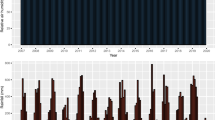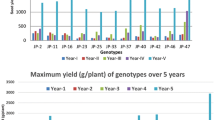Abstract
Jatropha curcas has become a prominent source of biofuel, especially because of the high oil content in its fruit. The aim of this study was to test different statistic models and compare the best-fitted model with the compound symmetry model and study the grain yield persistence of J. curcas progenies. A total of 730 individuals from 73 half-sib families were evaluated for the fruit yield trait over six crop years. Repeated measures models with different covariance structures for the genetic and non-genetic effects were tested. Results show an increase up to in accuracy upon modeling the genetic and non-genetic effects when compared to the compound symmetry model. The selection gain obtained via the best-fit model for 10, 15, 20, and 25 selected best progenies was around 3 to 2% higher than gain obtained via the standard statistical model used by breeders (compound symmetry model). The harvests evaluated exhibited accuracies of high magnitude. The ten progenies that stood out with the best genetic performance are also those with the greatest persistence and greatest accumulated yield. Combining modeling of covariance structures for grain yield and selecting for persistence of production can sustain a successful long-term J. curcas breeding program.




Similar content being viewed by others
Data availability
The datasets generated during and/or analyzed during the current study are available from the corresponding author on reasonable request.
Code availability
The code and data are available at https://github.com/JenifferSPCE/Jatropha_cov.
References
Acharya JP, Lopez Y, Gouveia BT et al (2020) Breeding alfalfa (medicago sativa l.) adapted to subtropical agroecosystems. Agronomy 10:742. https://doi.org/10.3390/agronomy10050742
Achten WMJ, Maes WH, Reubens B et al (2010) Biomass production and allocation in Jatropha curcas L. seedlings under different levels of drought stress. Biomass Bioenerg 34:667–676. https://doi.org/10.1016/j.biombioe.2010.01.010
Akaike H (1974) A new look at the statistical model identification. IEEE Trans Autom Control 19:716–723. https://doi.org/10.1109/TAC.1974.1100705
Alherbawi M, McKay G, Mackey HR, Al-Ansari T (2021) Jatropha curcas for jet biofuel production: current status and future prospects. Renew Sustain Energy Rev 135:110396. https://doi.org/10.1016/j.rser.2020.110396
Bahadur B, Sujatha M, Carels N (2012) Jatropha, challenges for a new energy crop. Springer, New York, NY. https://doi.org/10.1007/978-1-4614-4915-7
Balzarini M (2002) Applications of mixed models in plant breeding. In: Kang MS (ed) Quantitative genetics, genomics and plant breeding. New York, NY, pp 353–363
Bouton JH (2012) Breeding lucerne for persistence. Crop Pasture Sci 63:95–106
Burgueño J (2018) Spatial analysis of field experiments. In: Glaz B, Yeater KM (eds) ASA, CSSA, and SSSA Books. American society of agronomy, crop science society of america, and soil science society of America, Inc., Madison, WI, USA, pp 319–344
Butler DG, Cullis BR, Gilmour AR, Gogel BJ (2018) ASReml-R reference manual Version 4. VSN International, Hemel Hempstead, UK Cavanaugh
Cavanaugh JE, Neath AA (2019) The akaike information criterion: background, derivation, properties, application, interpretation, and refinements. Wiley Interdiscip Rev Comput Stat 11:e1460
Chavarría-Perez LM, Giordani W, Dias KOG et al (2020) Improving yield and fruit quality traits in sweet passion fruit: evidence for genotype by environment interaction and selection of promising genotypes. PLoS ONE 15:e0232818
Cohen J (1960) A coefficient of agreement for nominal scales. Educ Psychol Meas 20(1):37–46
Cullis BR, Smith AB, Coombes NE (2006) On the design of early generation variety trials with correlated data. J Agric Biol Environ Stat 11:381–393
Faveri J, Verbyla AP, Pitchford WS et al (2015) Statistical methods for analysis of multi-harvest data from perennial pasture variety selection trials. Crop Pasture Sci 66:947. https://doi.org/10.1071/CP14312
Ferreira FM, Bhering LL, Fernandes FD et al (2021) Optimal harvest number and genotypic evaluation of total dry biomass, stability, and adaptability of elephant grass clones for bioenergy purposes. Biomass Bioenerg 149:106104
Ferreira FM, de Carvalho Rocha JR do AS, Alves RS et al (2020) Estimates of repeatability coefficients and optimum number of measures for genetic selection of Cynodon spp. Euphytica 216:1–11. https://doi.org/10.1007/s10681-020-02605-x
Henderson CR (1975) Best linear unbiased estimation and prediction under a selection model. Biometrics 31:423. https://doi.org/10.2307/2529430
Iglesias DJ, Cercós M, Colmenero-Flores JM et al (2007) Physiology of citrus fruiting. Brazilian J Plant Physiol 19:333–362
Kozak M, Piepho HP (2018) What’s normal anyway? Residual plots are more telling than significance tests when checking ANOVA assumptions. J Agron Crop Sci 204:86–98. https://doi.org/10.1111/jac.12220
Laviola BG, Rodrigues EV (2019) Pinhão-manso pesquisas, conhecimentos e práticas. Embrapa Agroenergia-Livro técnico (INFOTECA-E) 1:420
Melo DT, Marc DS, Silva R, Anjos P (2020) Modeling (co)vari- ance structures for genetic and non-genetic effects in the selection of common bean progenies. Euphytica 216:77. https://doi.org/10.1007/s10681-020-02607-9
Mrode RA (2014) Linear models for the prediction of animal breeding values, 3rd edn. CABI, Boston, MA
Nielsen HB, Almeida M, Juncker AS et al (2014) Identification and assembly of genomes and genetic elements in complex metagenomic samples without using reference genomes. Nat Biotechnol 32:822–828
Patterson HD, Thompson R (1971) Recovery of inter-block information when block sizes are unequal. Biometrika 58:545–554
Peixoto L, Laviola BG, Bhering LL et al (2016) Oil content increase and toxicity reduction in jatropha seeds through family selection. Ind Crops Prod 80:70–76
Peixoto MA, Alves RS, Coelho IF et al (2020) Random regression for modeling yield genetic trajectories in Jatropha curcas breeding. PLoS ONE 15:e0244021
Peixoto MA, Evangelista JSPC, Coelho IF et al (2021) Multiple-trait model through Bayesian inference applied to Jatropha curcas breeding for bioenergy. PLoS ONE 16:1–11. https://doi.org/10.1371/journal.pone.0247775
Pereira FAC, De Carvalho SP, Rezende TT et al (2018) Selection of coffea arabica L. Hybrids using mixed models with different structures of variance-covariance matrices. Coffee Sci 13:304–311. https://doi.org/10.25186/cs.v13i3.1444
Piepho H-P (1997) Analyzing genotype-environment data by mixed models with multiplicative terms. Biometrics 53:761–766. https://doi.org/10.2307/2533976
Raza W, Saulat H, Shams UI et al (2015) Renewable energy resources current status and barriers in their adaptation for Pakistan. J Bioprocess Chem Eng 3:1–9
de Resende MDV, Alves RS (2020) Linear, generalized, hierarchical, bayesian and random regression mixed models in genetics/genomics in plant breeding. Funct Plant Breed J 2:1–31
Riday H, Brummer EC (2006) Persistence and yield stability of intersubspecific alfalfa hybrids. Crop Sci 46:1058–1063
Rocha JR do AS de C, Nunes KV, Carneiro ALN, et al. (2019) Selection of superior inbred progenies toward the common bean ideotype. Agron J 111:1181–1189. https://doi.org/10.2134/agronj2018.12.0761
Rocha JRAS, Marçal T, Salvador FV et al (2018) Genetic insights into elephant grass persistence for bioenergy purpose. PLoS ONE 13:1–16. https://doi.org/10.1371/journal.pone.0203818
Rodrigues EV, Rocha JR do AS de C, Alves RS, et al. (2020) Selection of jatropha genotypes for bioenergy purpose: an approach with multitrait, multiharvest and effective population size. Bragantia 79:346–355. https://doi.org/10.1590/1678-4499.20200046
Silva JO da C, Horst Bruckner C, Crescêncio Souza Carneiro P et al (2020) Estimates of genetic parameters and repeatability coefficients in s2 peach genotypes grown in a subtropical environment. Funct Plant Breed J 2:25–33. https://doi.org/10.35418/2526-4117/v2n1a3
Sivakumar D, Vankeswaram SK, Sakthikumar R et al (2016) An experimental study on Jatropha-derived alternative aviation fuel sprays from simplex swirl atomizer. Fuel 179:36–44. https://doi.org/10.1016/j.fuel.2016.03.050
Smith A, Cullis B, Thompson R (2001) Analyzing variety by environment data using multiplicative mixed models and adjustments for spatial field trend. Biometrics 57:1138–1147
Smith AB, Cullis BR, Thompson R (2005) The analysis of crop cultivar breeding and evaluation trials: an overview of current mixed model approaches. J Agric Sci 143:449–462
Souza VF de, Ribeiro PC de O, Vieira Junior IC, et al (2021) Exploring genotype× environment interaction in sweet sorghum under tropical environments. Agron J 113:3005–3018
Tiwari AK, Kumar A, Raheman H (2007) Biodiesel production from jatropha oil (Jatropha curcas) with high free fatty acids: an optimized process. Biomass Bioenerg 31:569–575
Verbyla AP (2019) A note on model selection using information criteria for general linear models estimated using REML. Aust N Z J Stat 61:39–50.https://doi.org/10.1111/anzs.12254
Wilkins PW, Humphreys MO (2003) Progress in breeding perennial forage grasses for temperate agriculture. J Agric Sci 140:129–150. https://doi.org/10.1017/S0021859603003058
Acknowledgements
We express our appreciation for financial support from the Fundação de Amparo à Pesquisa do Estado de Minas Gerais (FAPEMIG), the Conselho Nacional de Desenvolvimento Científico e Tecnológico (CNPq), and the Coordenação de Aperfeiçoamento de Pessoal de Nível Superior (CAPES)—financing code 001.
Funding
This research was supported by the National Institute of Science and Technology of Coffee (INCT Café), Minas Gerais State Agency for Research and Development (FAPEMIG), Brazilian National Council for Scientific and Technological Development (CNPq), and Coordination for the Improvement of Higher Education Personnel (CAPES)—Finance Code 001.
Author information
Authors and Affiliations
Contributions
All authors contributed to the study and conception and design.
Corresponding author
Ethics declarations
Conflict of interest
The authors declare no competing interests.
Additional information
Communicated by F.P. Guerra
Publisher's note
Springer Nature remains neutral with regard to jurisdictional claims in published maps and institutional affiliations.
Supplementary Information
Below is the link to the electronic supplementary material.
Rights and permissions
Springer Nature or its licensor (e.g. a society or other partner) holds exclusive rights to this article under a publishing agreement with the author(s) or other rightsholder(s); author self-archiving of the accepted manuscript version of this article is solely governed by the terms of such publishing agreement and applicable law.
About this article
Cite this article
Evangelista, J.S.P.C., Peixoto, M.A., Coelho, I.F. et al. Modeling covariance structures and optimizing Jatropha curcas breeding. Tree Genetics & Genomes 19, 21 (2023). https://doi.org/10.1007/s11295-023-01596-9
Received:
Revised:
Accepted:
Published:
DOI: https://doi.org/10.1007/s11295-023-01596-9




